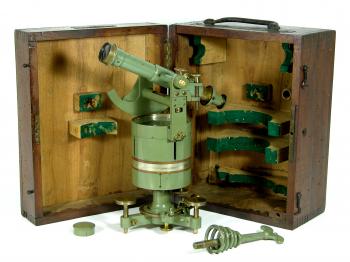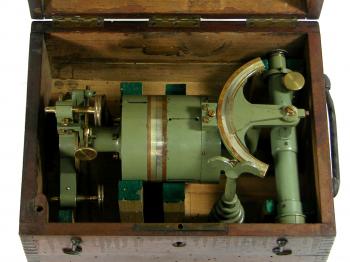20th century Pantometre à LunetteIn the last week of 2016 this Pantometre à Lunette (pantometer with telescope) was auctioned on-line. Being complete with its original box and most of its accessories it was a temptation simply too hard to resist. The instrument arrived in the collection in the first week of January 2017. The Pantometre à Lunette is a development based on the normal pantometer. Older versions of the instrument do not have a tribrach like this one here, while more elaborate specimens are known, having a vial on top of the telescope like an American transit and an adjustable yoke to allow setting the secondary axis perpendicular to the primary. Basically the addition of the tribrach and telescope to the pantometer made this instrument a simple theodolite, like the cercle d'alignement. Having a partial vertical limb the Pantometre à Lunette can even measure vertical angles making the instrument comparable to the Keuffel & Esser transit in the collection, although that is a more sophisticated instrument. Accuracy The horizontal limb is 90 millimetres in diameter and is divided all the way around in whole degrees. The vernier divides each degree into 30 parts, readings can thus be taken at a two arc minute level (see figure 11). The vertical limb is approximately 125 millimetres in diameter and is divided into half degrees, each of which is divided into 30 parts by the double reading vernier. The vertical angles can thus be read at a single arc minute level (see figure 10). Whether the Pantometre à Lunette actually was that accurate could be argued. The horse hair visors easily hide large objects, like a church tower (see figure 17). The vernier of the vertical limb is attached with a single clamping screw to the secondary axis and easily gets deranged. As the instrument does not allow to transit the telescope, there is no way for the surveyor to verify the true setting of the vernier. In addition the index arm has no fine adjustment screw to calibrate it with high precision. This means that even when using a Leica Total Station as collimator it was far from easy to get the vernier well adjusted. The compass is divided in whole degrees and runs from 0 to 360 degrees. The needle has a length of approximately 65 millimetres. The wind rose is annotated N, E, S, O, which could stand for the Italian Nord, Est, Sud, Ovest or the French Nord, Est, Sud, Ouest. It could thus well be that despite being traded in Italy that the instrument was of French origin. The Instrument The instrument came in its original wooden case with a label of Vittorio la Barbera, who was a 'general representative' (retailer) in Naples (see figure 6). The label states that La Barbera had his shop at Via Roma 201-203,1 which was in front of the Central Funicolare,2 the cable car in the centre of Naples. As the Funicolare opened in October 1928, the instrument must have been made in or after this year.3 La Barbera is known to have been active at this address as early as 1930.4 The instrumentThe instrument was remarkably complete and came with its original lens cap (see figure 4), mounting rod and pressure spring (see figure 15), and wooden case. When it arrived it became immediately clear that I had bought more than just an instrument in a wooden case. Upon opening of the package more wood dust fell out of it than was produced during the construction process of the case itself, making it absolutely clear that it was inhabited by some sort of woodworm. The freshness of the holes in the wood (see figure 4, figure 5, and figure 6)was a good indication that this was a still ongoing process. In order to stop this, I fired up our electric oven and over an hour slowly heated the box until a temperature of 75°C was reached. It was left at that temperature for another half hour, all the time monitoring its temperature using an oven gauge. The heat treatment did not result in any additional visual damage to the case, but has hopefully cooked the inhabitants. The wood dust was further removed using compressed air and for certainty the case is now stored in a plastic sealed container to monitor if its inhabitants have perished. After having cleared this issue, a further inspection of the instrument revealed a broken secondary axis as a result of which the clamping mechanism no longer worked. It had been repaired in a clumsy way, even using a steel cylinder head screw (a sin on a boussole instrument!). I made a new screw on my lathe (compare figure 8 and figure 9) and replaced the broken section of the axis, which is now firmly attached and works properly again. Two of the three visors did no longer have a wire in them, while the third had a non-original metal wire. Loosening the screws showed remains of the original horse-hairs, which have now been inserted in all three visors. Notes[1]: This is now Via Toledo.[2]: The Funicolare station is not situated at the Via Roma (now Via Toledo). Currently the offices of Funicolare Centrale are situated at Piazzetta Duca d'Aosta, a square next to Via Toledo (see this picture with green sign post). It may have moved here in 1995 when the line was taken over by ANM. When La Barbera had his shop the offices were around his location, most likely around the current Via Toledo 201. [3]: See Central Funicular page on WikiPedia. [4]: See 1930 picture of Vittorio Emanuele III bearing La Barbera's stamp. If you have any questions and/or remarks please let me know. |
Surveyor's crosses... Geodetic Sextants... Theodolites... Total Stations... Levels... Standards... Tools... Firms...
Equerre 19th century Pantometer? 20th century Pantometer Pantometre à Lunette 17th c. Surveyor's Cross Pseudo Holland Circle Graphometer

















